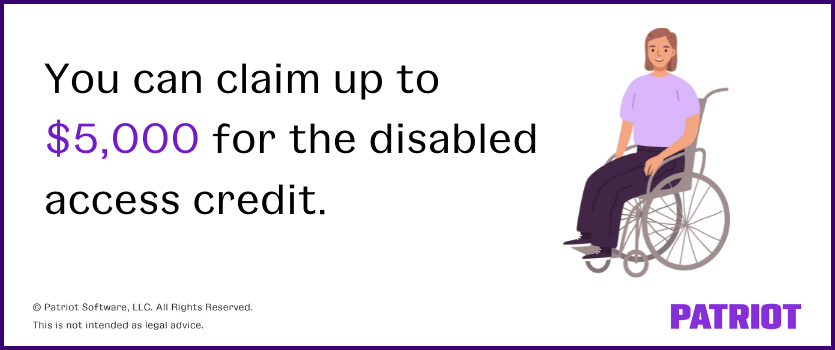As a small business owner, it’s your responsibility to make your company more accommodating for employees, customers, and other individuals with disabilities. And, did you know that qualifying small businesses can claim a tax credit for doing so? Learn about the disabled access credit to find out if you’re eligible.
What is the disabled access credit?
The Americans with Disabilities Act (ADA) prohibits discrimination against individuals with disabilities in public places, like businesses, workplaces, and transportation. To comply with ADA guidelines, businesses may need to spend money making their buildings more accommodating and accessible. The IRS provides the disabled access credit, or ADA tax credit, to offset these costs.
The disabled access credit is a tax credit qualifying small business owners can claim for incurring eligible access expenses.
So, what are eligible access expenses? Eligible access expenses are costs businesses incur when they improve accessibility for individuals with disabilities. Installing a ramp for wheelchairs or purchasing headphones for those with hearing impairments are examples of eligible access expenses.
Eligible access expenses also include reasonable accommodations. Reasonable accommodations are modifications businesses make to help candidates and employees with disabilities perform their jobs. However, you cannot claim the tax credit for providing reasonable accommodations that don’t cost you money.
Are you eligible for the disability tax credit?
To qualify for the disabled access credit, you must be a qualifying small business and spend money on eligible IRS access expenses.
Qualifying small businesses
Not all businesses can claim the ADA credit. You must meet the IRS’s small business definition to qualify.
According to the IRS, you can claim the disability tax credit if you:
- Had $1 million or less in gross receipts for the preceding tax year OR had 30 or fewer full-time employees
- Elect to claim the disabled access credit for the tax year
The IRS defines full-time employees as those who work at least 30 hours per week for 20 or more weeks during the year.
Eligible access expenses
For disability tax credit eligibility, you must spend money on qualifying purchases.
According to the IRS, eligible access expenses include purchases to:
- Remove barriers that prevent accessibility for individuals with disabilities
- Provide qualified interpreters or make audio materials available to hearing-impaired individuals
- Provide qualified readers, taped texts, and other ways to make visual materials available to visually-impaired individuals
- Acquire or modify equipment or devices for individuals with disabilities
In addition to meeting one of the above requirements, the expense must be reasonable and necessary. And, it can only be for adapting your current building, not for new construction.
The IRS defines individuals with disabilities as those who meet one of the following requirements:
- Has a physical or mental impairment that substantially limits one or more major life activities
- Has a record of an impairment
- Is regarded as having an impairment
Disability tax credit amount
The disability credit is worth 50% of your eligible access expenses, up to a maximum of $10,250. You cannot claim a credit for the first $250 in expenses. The maximum tax credit you can claim is $5,000.

Keep in mind that a tax credit directly reduces your tax bill. If you claim the disabled access credit, you could potentially reduce your tax bill by $5,000.
There is no disability tax refund. The disabled access credit is nonrefundable. This means you cannot receive a refund, even if the tax credit is higher than what you owe.
Disability tax credit form
The disabled access credit is part of the general business tax credit. To claim the credit, attach Form 8826, Disabled Access Credit, to your tax return. And, attach Form 3800, General Business Credit.
Not eligible for the tax credit? Take the deduction instead
Businesses that don’t meet the IRS small business requirement cannot take the disabled access tax credit. However, they may be able to claim the disabled access tax deduction.
What’s the difference?
A tax credit reduces a taxpayer’s total tax bill. On the other hand, a deduction reduces a taxpayer’s total tax liability.
Businesses that incur eligible access expenses can claim a maximum deduction of $15,000 per year. Any size business that spends money making their facility or public transportation vehicle more accessible to the disabled or elderly can claim the deduction.
For more information on the barrier removal cost tax deduction, check out IRS Publication 535.
If you want to claim the disabled access credit, you need to know how much your eligible access expenses are. Use Patriot’s online accounting software to make tracking expenses a breeze. And, we offer free, U.S.-based support. Start your free trial now.
This article is updated from its original publication date of May 14, 2019.
This is not intended as legal advice; for more information, please click here.


